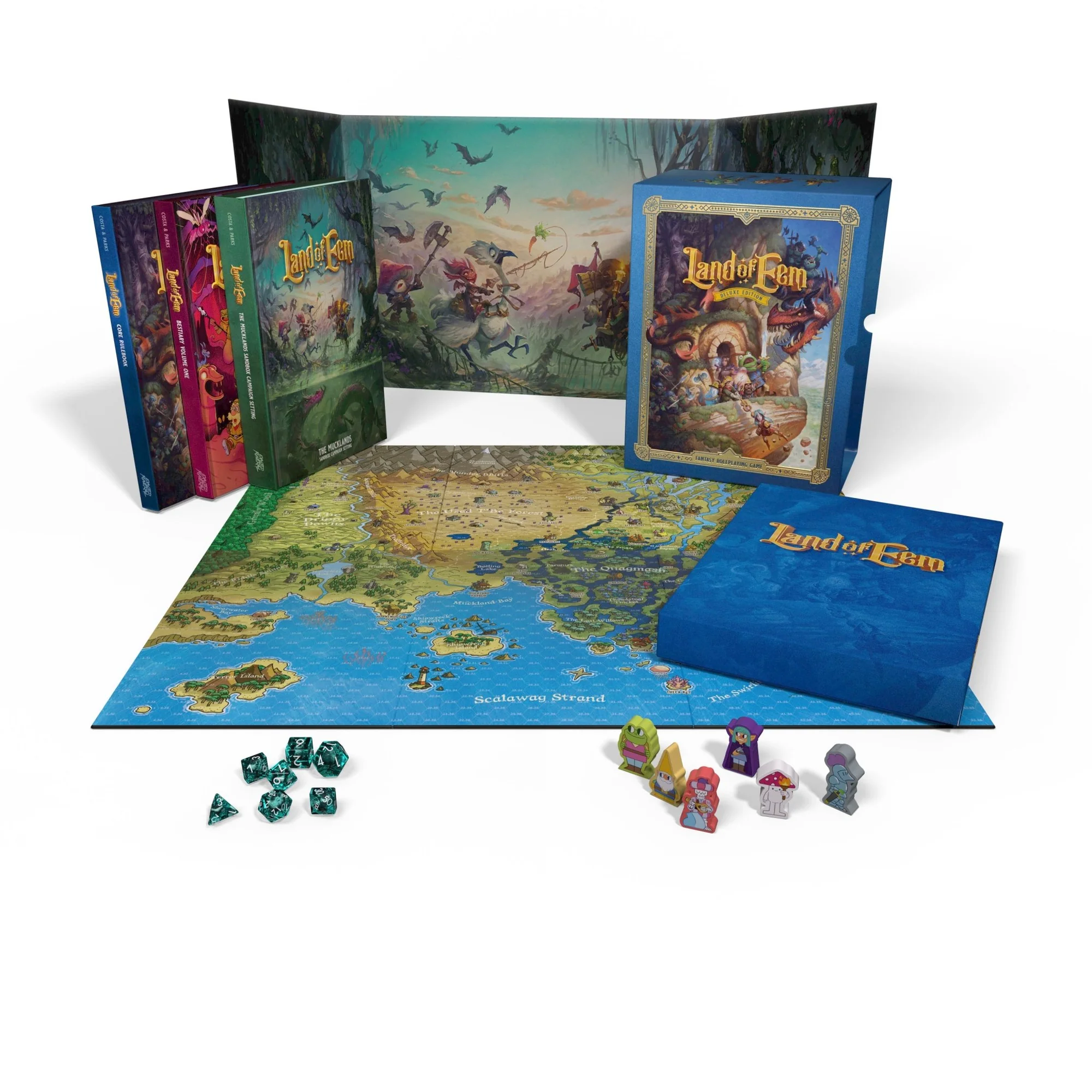Scott at the Tabletop #2 (April 2025)
It has been a HUGE month for RPG books at ECAV – Tabletop HQ! We have some amazing stuff to review from both Free League and Exalted Funeral, which includes one of the biggest box sets I’ve seen for a new RPG in years.
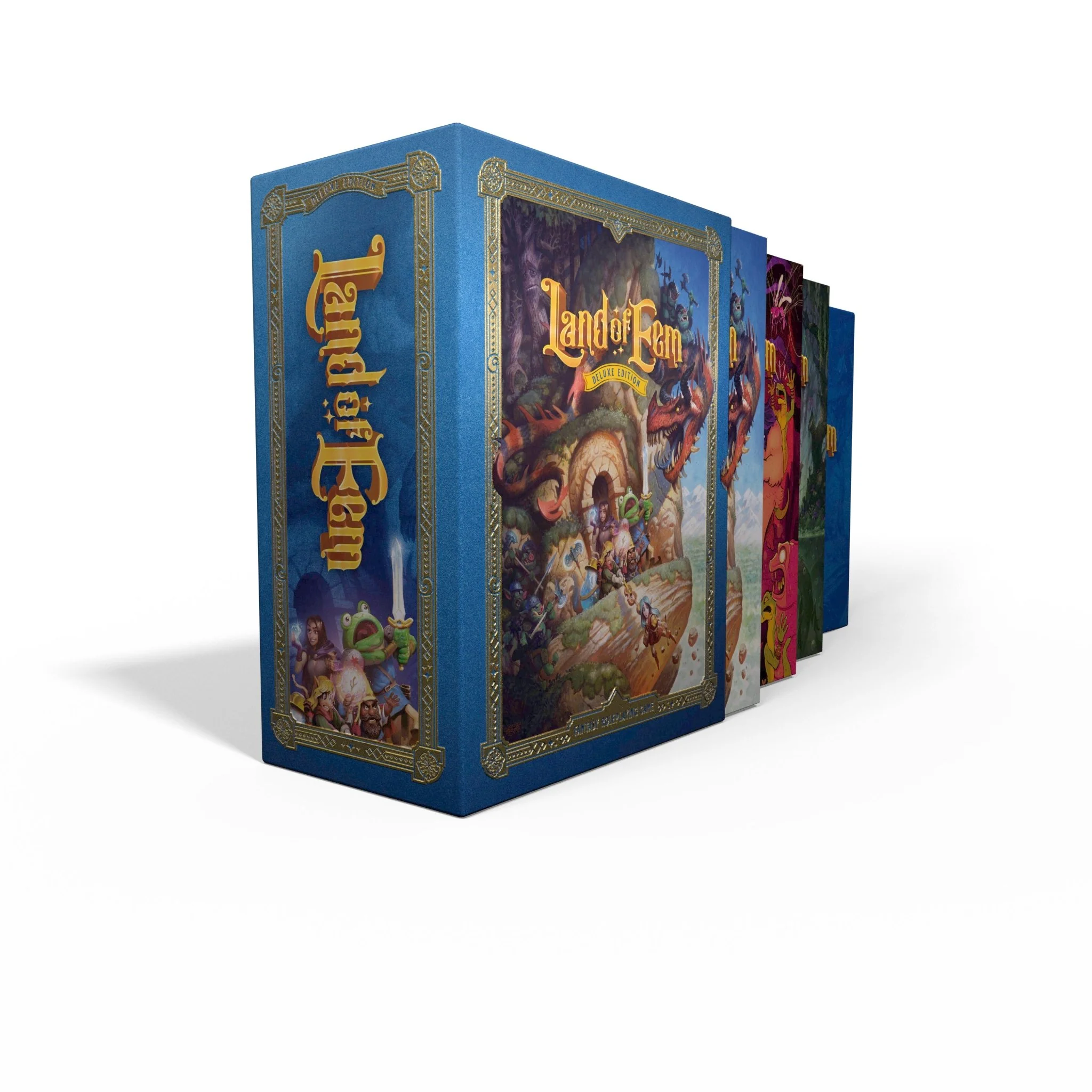
Land of Eem (Deluxe Box Set)
I am a forever GM that is quite satisfied with being in that position. That being said I’m always looking to play things that are new and unique (I should specify new to me, though in this case it is actually 100% new and definitely unique). Land of Eem is an RPG that has been described to death as Muppets meets Lord of the Rings, it would be dishonest to disagree with that since it is lovingly all over this game system, but growing up in the early 80’s at Jim Henson’s creative peak, I couldn’t help but field comparisons to Henson’s Labyrinth and Dark Crystal films (as well as the Storyteller TV series), as well as the famed Kermit-led squad of anthropomorphic animals. Going through all 3 books in the set (as well as all the other accouterments in the box) you can see this influence on almost every page. The RPG itself is based on 2 graphic novel series Rickety Stitch and Dungeoneer Adventures.
It could be said the D12 is one of the most underrated of dice in a typical set. The D20 is the D&D standard used in many other RPG’s as well, both the 10 and percentile die is the focus of the Chaosium BRP system as well as used in games like Warhammer Fantasy Roleplay, D6’s are at the heart of games like Traveller as well as Free League’s Year Zero Engine, and Cyberpunk’s Interlock system is based around D10 rolls. What we have here is a D12 based tiered resolution system something akin to a PBTA game, wins and losses both in combat and skill checks are in 5 tiers from critical hits, to winning, but with a twist to downright failures. This keeps the game flowing nicely from moment to moment as a PC is almost always guaranteed to do something that moves the game forward. Like D&D though this game is class and level based, with each level offering characters new abilities, and in some circumstances new titles.
The deluxe edition of Land of Eem is such a massive undertaking. I have always loved a complete game in a box, and this does that in spades. The second book in the set is a setting book for a world called the Mucklands. This world is divided into 6 major regions such as the Drippy Downs (standard fantasy land setting) to the Quagmash (which is a land of bogs and swamps). The box explains that this is a sandbox world, and should be approached as such. This gives the perception that the game should be played less as a narrative campaign world, and more of an OSR with overland and dungeon exploration with a twist of improv, and this book starts with suggested ways to run it as such. The final book is a Bestiary with 200 pages of sheer creature creativeness. Flipping through each section one can see bizarre creatures like the Bubblegoose and the Cankerboar, creatures that have real world elements with a cartoonish twist. The box also includes a board game style map of the Mucklands, a GM’s screen, and a box of meeples, dice, and other adventuring supplies. Land of Eem seems like the perfect game to play with family, especially one with young kids, that are looking to start adventuring.
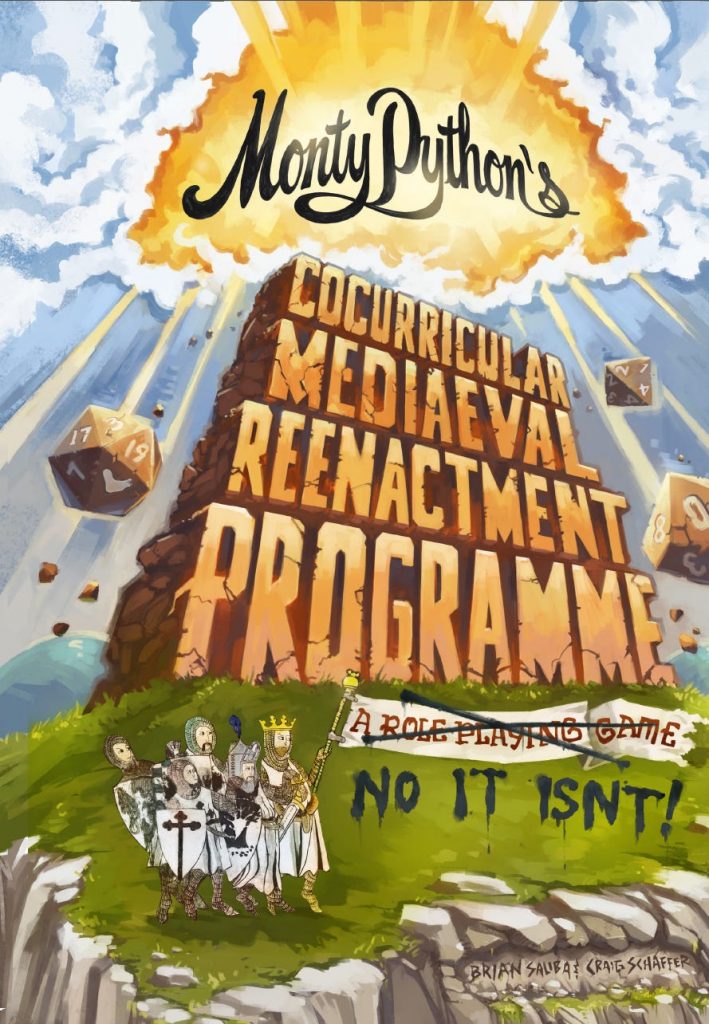
Monty Python’s Cocurricular Mediaeval Re-Enactment Programme
This is another new release from Exalted Funeral. I had been hearing about this book for a few years since the Kickstarter was about to hit, but was uninterested. My personal thoughts were if I wanted to play a Holy Grail game, I could just write a goofy Pendragon campaign. So when I went to crack the book open I was surprised to find it so absolutely delightful, not just as a reading experience, but as an overall homage to Monty Python, and having been a fan since the late 80’s when I found Holy Grail on VHS I couldn’t resist its charms. So first thing out of the way, this book is set in a medieval period similar to the Holy Grail movie, but if you are a Python fan you will find it references all their works to a degree from Flying Circus to the Meaning of Life, and beyond. This game does not have a GM, but a Head of Light Entertainment which has to be the coolest GM title since Call of Cthulhu came up with “Keeper of Arcane Lore”.
The system is built around a classes and traits. Critical wins and losses will affect your characters die roll in those skills going forward. For example if your PC fails a roll with the lowest possible die roll, they have to go down the dice chain by one step reducing the type of die they’ll have to roll next, the opposite happens with critical successes. Like the Land of Eem reviewed above, this game is less about rules, than creating a narrative with the cooperation of the HoLE and the PC’s. Rules are minimal, but offer more than enough to keep the system interesting through multiple play sessions. The book itself includes information on various factions operating at the time, history of the era, a rules primer, a section for both the HoLE and the players, and a series of quests. Monty Python’s Cocurricular Mediaeval Reenactment Programme might be the biggest TTRPG surprise I’ve seen so far this year. It works perfectly in its intended space creating an RPG filled with the ingenuity, chaos, and creativity of Monty Python themselves.
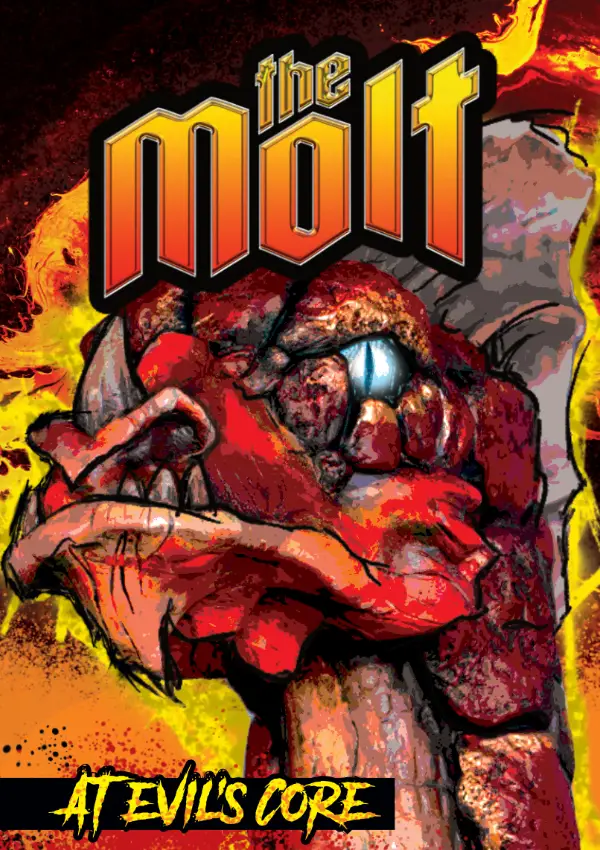
The Molt – Creature Curation/Exalted Funeral
The Molt is the latest creation of creator Brian Colin, who created the Vast Grimm sci-fi horror RPG. Like Vast Grimm, The Molt is a hack of Mork Borg, but while Vast Grimm had a minimal connection to the world of Mork Borg, The Molt takes place in that world’s interior. The setting for The Molt is “The Kor” basically the center of the Mork Borg planet. 6,666 years prior to the game taking place Fatuma, a warlock descended with his follower’s into the Grift, a crack that leads into the center of the planet. Those who survived the journey (this includes the two basilisk eggs they had with them) began to learn more arcane magic from those who lived below.
In a game of Mork Borg players are playing in a doomed world. When certain prophecies comes true the world will end (also you’ll have to burn the book, sorry I don’t make the rules). The descendants of those who followed Fatuma into the Kor believe that the world will end when cracks in the Kor become enough that the titular “Molt” will happen destroying the outer shell of the planet, and leaving them to dominate the remains. Like Mork Borg this is an all in one book, with elements of lore, character creation, rules, and a Molt setting bestiary.
The book also includes an introductory adventure A Crack in the Temple of Secrets which like Mork Borg’s Rotblack Sludge helps GM’s and players understand the tone of the game, which is a humorously dark RPG with elements of body horror (like Vast Grimm). For those unaware of the “Borg” games they are based on a D20 system where the player’s are in charge of the majority of rolls. When enemies attack players roll an Agility test (Presence) and if they will receive the damage based on the enemie’s damage die. These games are a variation on the OSR aesthetic basically keeping the rules straight-forward, but not based on BX D&D, rather simplifying things to create a fast and tight, yet still atmospheric experience. They did add one stat differing it from Mork Borg, and that is the “Focus” stat which is used for arcane magic. The one issue I have with the Molt, and in turn the Mork Borg line themselves, is they are an ADHD nightmare. The art is gorgeous, and helps set the tone for the game contained therein, but if you have attention-based issues then you will find yourself (if you’re at all like me) reading sections over and over as the graphic design of the material disrupts the flow of learning the rules. Honestly, though the rules are straight-foward enough that most readers can get the whole thing in less than an hour skipping over sections that are more geared to GM’s.
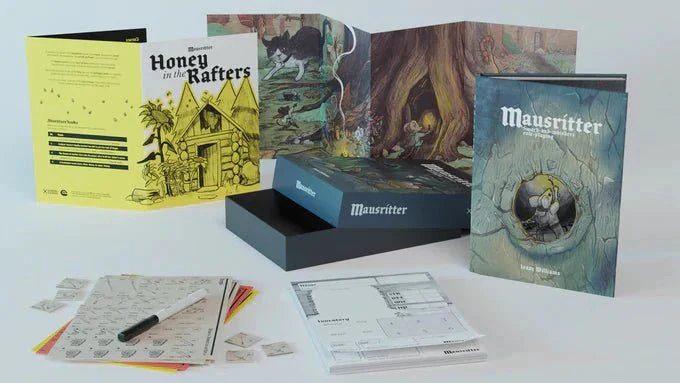
Mausritter Box Set (Exalted Funeral)
To get a bit personal for a moment, my daughter got married a little under 2 year’s ago. She is almost done with college, and so I know Grandkid’s are on the horizon. This had me thinking about things, one of which is tabletop gaming with young kids. I’ve been a tabletop gamer practically my whole life, but after college and the early part of my marriage and career, I put all my gaming aside while I got life in order. My own kids didn’t have many early gaming experiences with me, but I want to make sure that my Grandkids get to experience the wonder of tabletop roleplaying, and learning the wonders of imagination play.
Games like D&D and RuneQuest are great, but they are way too heavy for young children(obviously), and then I found out about Mausritter. Mausritter is described on the box as a “Sword and Whiskers” game where PC’s will have to take charge of a mouse adventurer. The system is roll under similar to Into the Odd, and each character only has 3 stats (STR, DEX, WIL). This makes processing the rules easy, and getting a character to the table in minutes.
The box set includes a rule book with 2 sections one for the GM and another for the players (and in turn the GM to get the rules down). The player’s section details how to play the game, creating a character, how rolls are made and combat works as well as elements like resting, magic, and overland healing as well as hiring help. The GM’s section flips that to a GM’s perspective and shows when to call for saves, how to handle overland travel, a small bestiary, and how to create and utilize adventure sites. The book is 43 pages and could probably be read in one sitting. The box also includes a notepad full of character sheets (this game is simple, but lethal), a very effective GM’s screen which puts all the most necessary tables right in the GM’s purview, and a starter module called “The Honey in the Rafters”, which offers locations, factions, and tips rather then creating a beginning, middle, end narrative. This is a great way to introduce players to the game, or to add to an existing game. There are also rules references, and inventory cards that can be used on top of a character sheet. This is an amazing little product, and could easily be played within hours of purchasing.
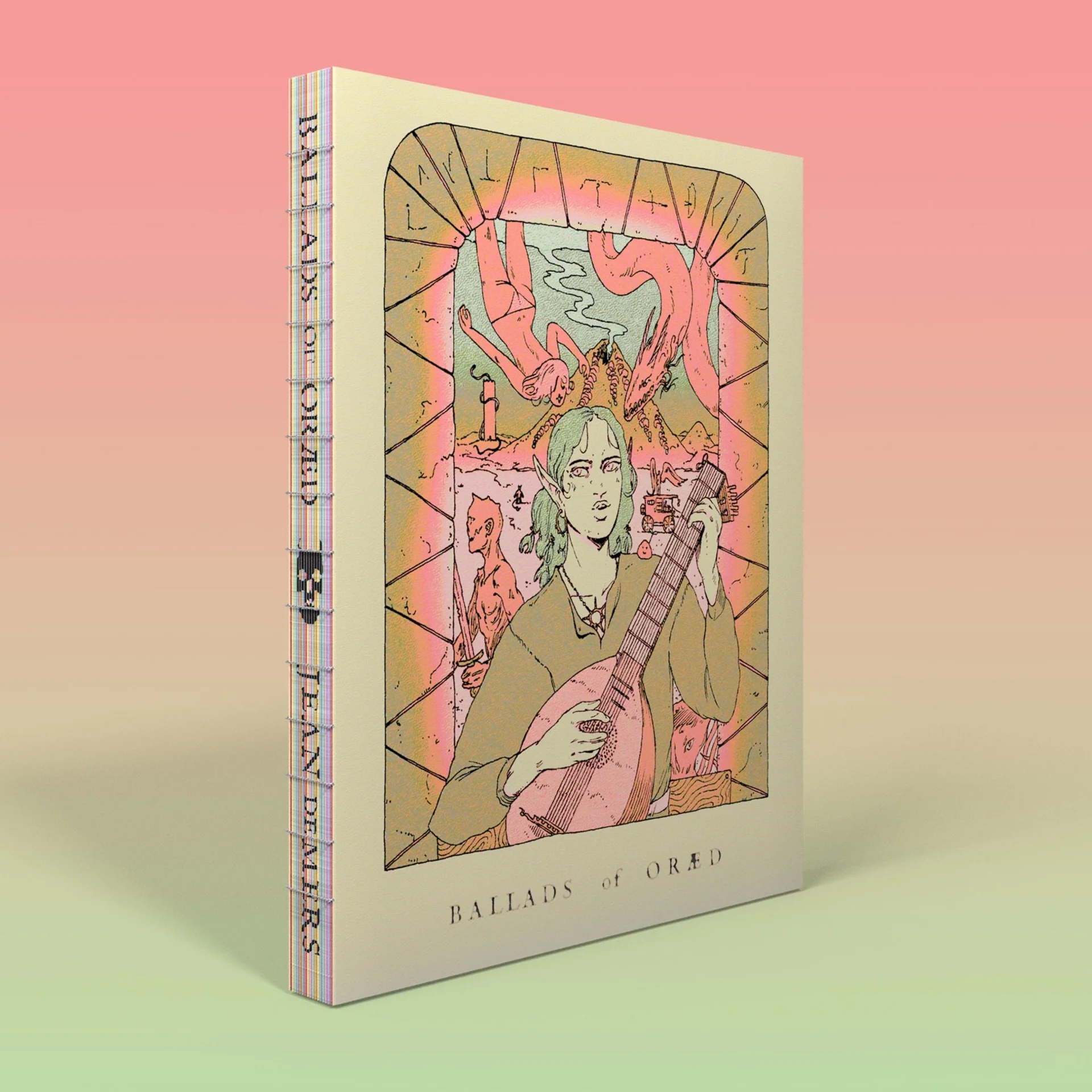
Ballads of Oraed (Old School Essentials) – Exalted Funeral
Old School Essentials for those unaware are a cleaned up version of the Basic/Expert D&D rule set from the early 1980’s. The books are written in a well-written, easy to understand form, but it is just the rules. The Old School Essentials books do not even include play examples to help understand the rules for new players, and as the volumes that form Old School Essentials are so matter of factly written they certainly don’t have a setting in mind. Some GM’s might be looking to use the B/X setting of Mystara, others might want to jump into OSE author Gavin Norman’s new fantasy setting Dolmenwood, for those that are keeping their options open Jean deMer’s Ballads of Oraed might be up their proverbial alley.
If there is one commonality between all the Exalted Funeral books I’ve written about in this column thus far it is the abundance of fantastic art from the Gilliam-esque graphics of the Monty Python RPG to the grimdark, body-horror fantasy of The Molt and beyond. The Ballads of Oraed is no different, the book itself is 230 pages, and at least half of this is filled with gorgeously rendered fantasy art. The book itself opens with an Atlas of the land of Oraed. This section introduces the races of Oraed as well gives users a variety of maps showing off the Oraed-ian landscape. The book then goes into a section called Six Teeth and Other Tales of the Sea. This section is water focused and discusses aspects of the island region of Oraed, it has details on factions of the region, watercrafts, weather charts which will impact travel, equipment, and encounters.
At this point the Ballads of Oraed becomes adventure focused with adventures following different aspects of Oraed. The first 2 adventures are island focused as the chapter leading up to them sets up, then we get to lands through a magic portal in an adventure called the Wish Wyrm, before entering a more urban fantasy setting in Imps in Allistorch. The book then segues into a comic called Silence in the Poison Lands, which shows off a new aspect of the setting before going on an adventure in the same lands. Beyond that there are more adventures, throughout the setting. The book largely concludes with a bestiary and about 20 pages of art that help to bring the setting to life.
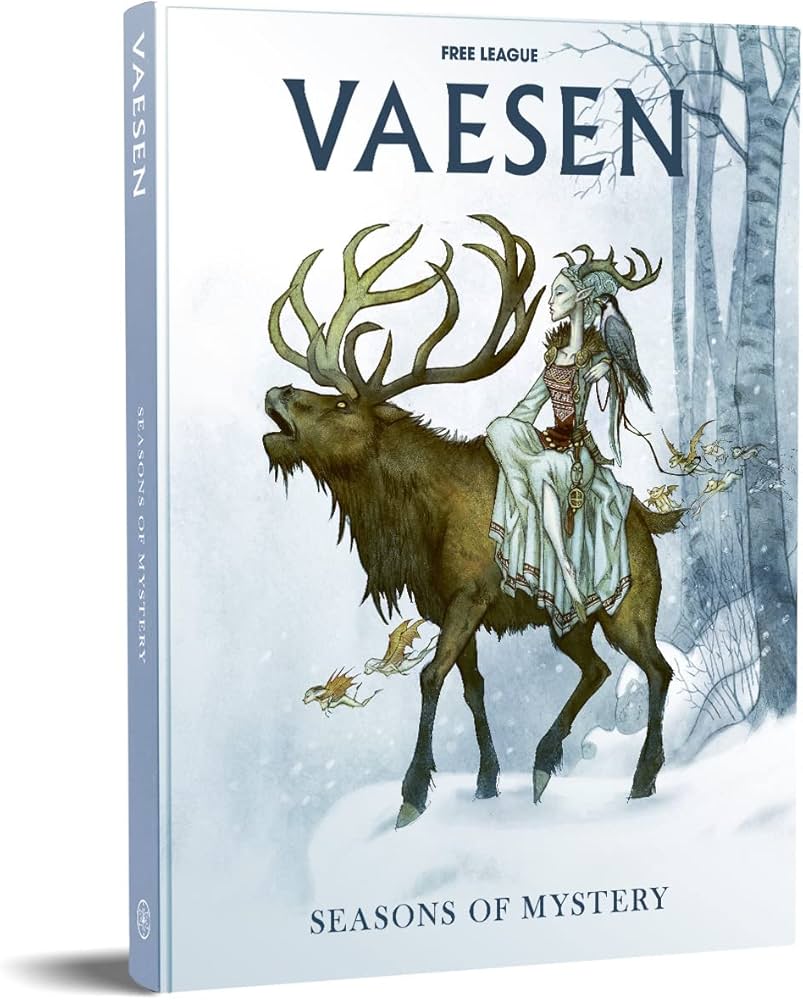
Vaesen – Seasons of Mystery/Mythic Britain and Ireland
Vaesen has become one of my favorite game systems as of late. After I received, read, and reviewed the core rulebook (and the Lost Mountain Saga) for the 2024 ECAV Gift Guide, I began running one on one sessions with my wife. Even playing 1:1 Vaesen works exceptionally well using it’s variant on Free League’s Year Zero engine to tell stories of folklore based horror. Vaesen is a rather new system, and has about 5 books (including the core) available for purchase (a few new ones have been Kickstarted recently). Needless to say I wanted more Vaesen so decided to look into Season of Mystery and Mythic Britain and Ireland, the former is a collection of 4 adventures that fall across all four seasons starting in Spring. The latter is a source book of information on running a Vaesen campaign in the UK and Ireland.
Seasons of Mystery opens with a springtime mystery, A Dance with Death, that sees the PC’s who are members of a society of those with “sight” (people who can see Vaesen). They are brought to the town of Dalarna to explore the cause behind a series of drownings of young women. The police have no clue what is behind it, and the person inviting them thinks it has to do with Vaesen. The second scenario set in the summer is “Fireheart” and takes place in the South of Sweden and is set around an Ironworks where a man fears the potential antics of his money-hungry brother. The third scenario in the book is the autumnal module “The Devil on the Moor”. This is an absolutely creepy scenario that takes place in Denmark in a cold and dark moorland. The final module “The Winter’s Tale” is a very character derived semi-minimalist scenario that sees the adventures on the border with Russia, in an isolated locale when a winter storm hits, and they are forced to take shelter in an isolated inn.
All the scenarios in the book have an effective mix of charm and creepiness. One thing I have to discuss when reviewing Vaesen is Free League’s use of warnings when starting an adventure. Each scenario in this book (and every other Vaesen adventure) is given notes about what occurs in the adventure such as child death (The Winter’s Tale, The Devil on the Moor) or mind control (A Dance with Death). This really helps me as a GM select modules tailored to my players before I start reading and preparing them.
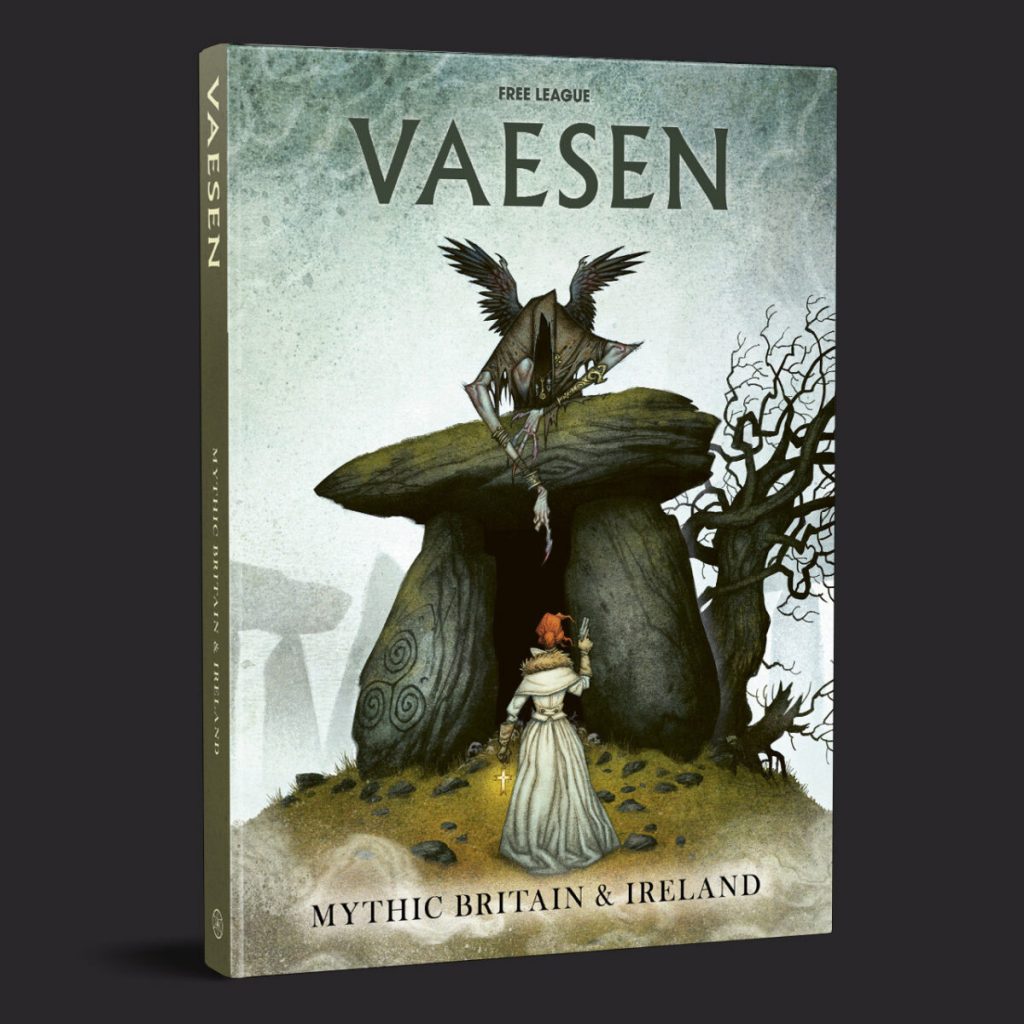
Vaesen is set in Sweden and Scandinavia. If one is to play by the core rulebook, then your party will be based out of Uppsala, Sweden where the society has a house that they are investigating and restoring between sessions of the game. That being said there is a whole world of mythical creatures out there, and so Free League decided to expand the scope of the game by adding in the Mythic Britain and Ireland sourcebook. This book is masterminded by Graeme Davis (Warhammer Fantasy Roleplay), who creates a neat little book for investigators in the UK and Ireland. The book details the history of the society in England, their headquarters “Rose House” in London, and landmarks around the area. However, if London is not a place your group wants to run a game, then the book gives background on notable British and Irish cities that a game could be set in, plus details about things like rural life in the region and mysterious places. We then get a UK/Ireland bestiary which includes such iconic regional folklore creatures such as the Nuckleavee, Redcaps, and Boggarts. The book concludes with 3 scenarios (The Old Meg , The Llantywyll Incident , and The Hampstead Group) that take place in the region, and continue on with the charming + creepy vibe that Vaesen has succeeded so well in capturing.

